Dental Restoration Study Critique Report - [University Name]
VerifiedAdded on 2022/09/26
|5
|1159
|19
Report
AI Summary
This report is a critique of a study that evaluated the clinical performance of nanofilled and nanohybrid composites in Class IV cavities over a five-year period. The study, conducted on 34 patients, assessed the effectiveness of these materials in combination with etch-and-rinse adhesives. The report details the study's methodology, including patient selection, randomization of composite materials, restoration procedures, and evaluation criteria such as color matching, marginal discoloration, and retention. The critique highlights the strengths of the study, such as the clear definition of material properties, application techniques, and rigorous methods to reduce bias. The findings indicated a high success rate for both composite materials, particularly in color matching, marginal discoloration, retention, and the absence of caries. The report concludes that the study provides valuable insights into the efficacy of nanocomposites for Class IV restorations.
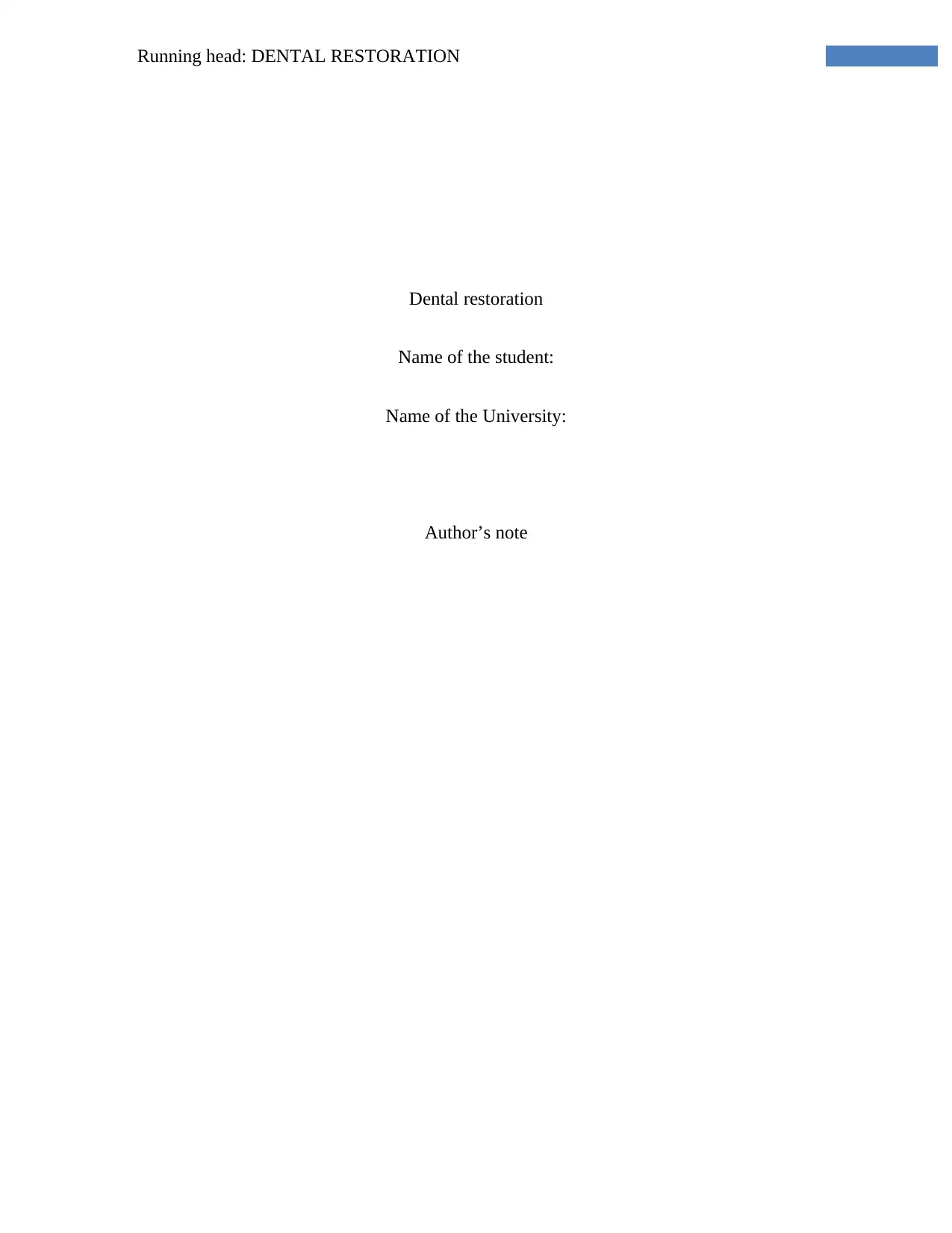
Running head: DENTAL RESTORATION
Dental restoration
Name of the student:
Name of the University:
Author’s note
Dental restoration
Name of the student:
Name of the University:
Author’s note
Paraphrase This Document
Need a fresh take? Get an instant paraphrase of this document with our AI Paraphraser
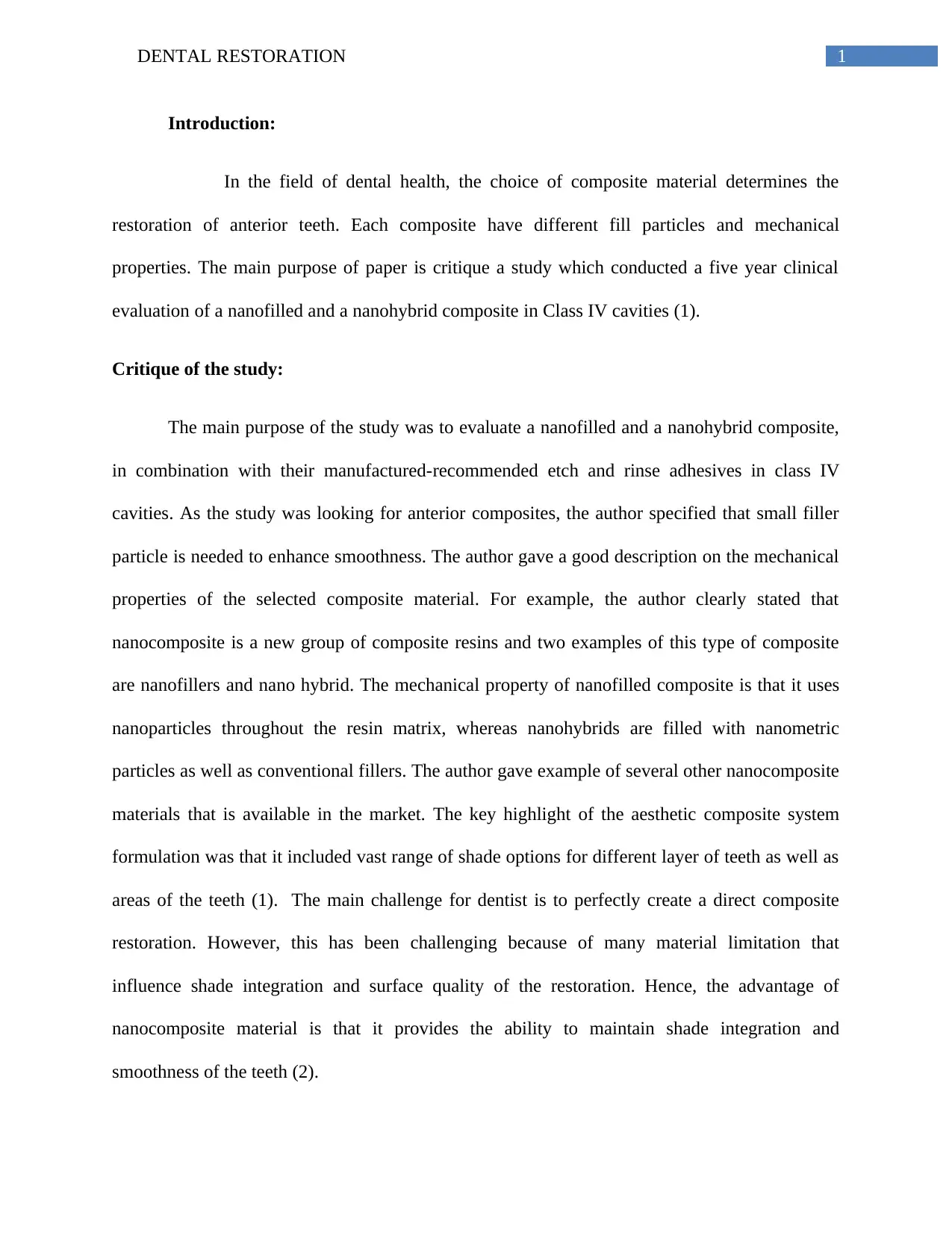
1DENTAL RESTORATION
Introduction:
In the field of dental health, the choice of composite material determines the
restoration of anterior teeth. Each composite have different fill particles and mechanical
properties. The main purpose of paper is critique a study which conducted a five year clinical
evaluation of a nanofilled and a nanohybrid composite in Class IV cavities (1).
Critique of the study:
The main purpose of the study was to evaluate a nanofilled and a nanohybrid composite,
in combination with their manufactured-recommended etch and rinse adhesives in class IV
cavities. As the study was looking for anterior composites, the author specified that small filler
particle is needed to enhance smoothness. The author gave a good description on the mechanical
properties of the selected composite material. For example, the author clearly stated that
nanocomposite is a new group of composite resins and two examples of this type of composite
are nanofillers and nano hybrid. The mechanical property of nanofilled composite is that it uses
nanoparticles throughout the resin matrix, whereas nanohybrids are filled with nanometric
particles as well as conventional fillers. The author gave example of several other nanocomposite
materials that is available in the market. The key highlight of the aesthetic composite system
formulation was that it included vast range of shade options for different layer of teeth as well as
areas of the teeth (1). The main challenge for dentist is to perfectly create a direct composite
restoration. However, this has been challenging because of many material limitation that
influence shade integration and surface quality of the restoration. Hence, the advantage of
nanocomposite material is that it provides the ability to maintain shade integration and
smoothness of the teeth (2).
Introduction:
In the field of dental health, the choice of composite material determines the
restoration of anterior teeth. Each composite have different fill particles and mechanical
properties. The main purpose of paper is critique a study which conducted a five year clinical
evaluation of a nanofilled and a nanohybrid composite in Class IV cavities (1).
Critique of the study:
The main purpose of the study was to evaluate a nanofilled and a nanohybrid composite,
in combination with their manufactured-recommended etch and rinse adhesives in class IV
cavities. As the study was looking for anterior composites, the author specified that small filler
particle is needed to enhance smoothness. The author gave a good description on the mechanical
properties of the selected composite material. For example, the author clearly stated that
nanocomposite is a new group of composite resins and two examples of this type of composite
are nanofillers and nano hybrid. The mechanical property of nanofilled composite is that it uses
nanoparticles throughout the resin matrix, whereas nanohybrids are filled with nanometric
particles as well as conventional fillers. The author gave example of several other nanocomposite
materials that is available in the market. The key highlight of the aesthetic composite system
formulation was that it included vast range of shade options for different layer of teeth as well as
areas of the teeth (1). The main challenge for dentist is to perfectly create a direct composite
restoration. However, this has been challenging because of many material limitation that
influence shade integration and surface quality of the restoration. Hence, the advantage of
nanocomposite material is that it provides the ability to maintain shade integration and
smoothness of the teeth (2).
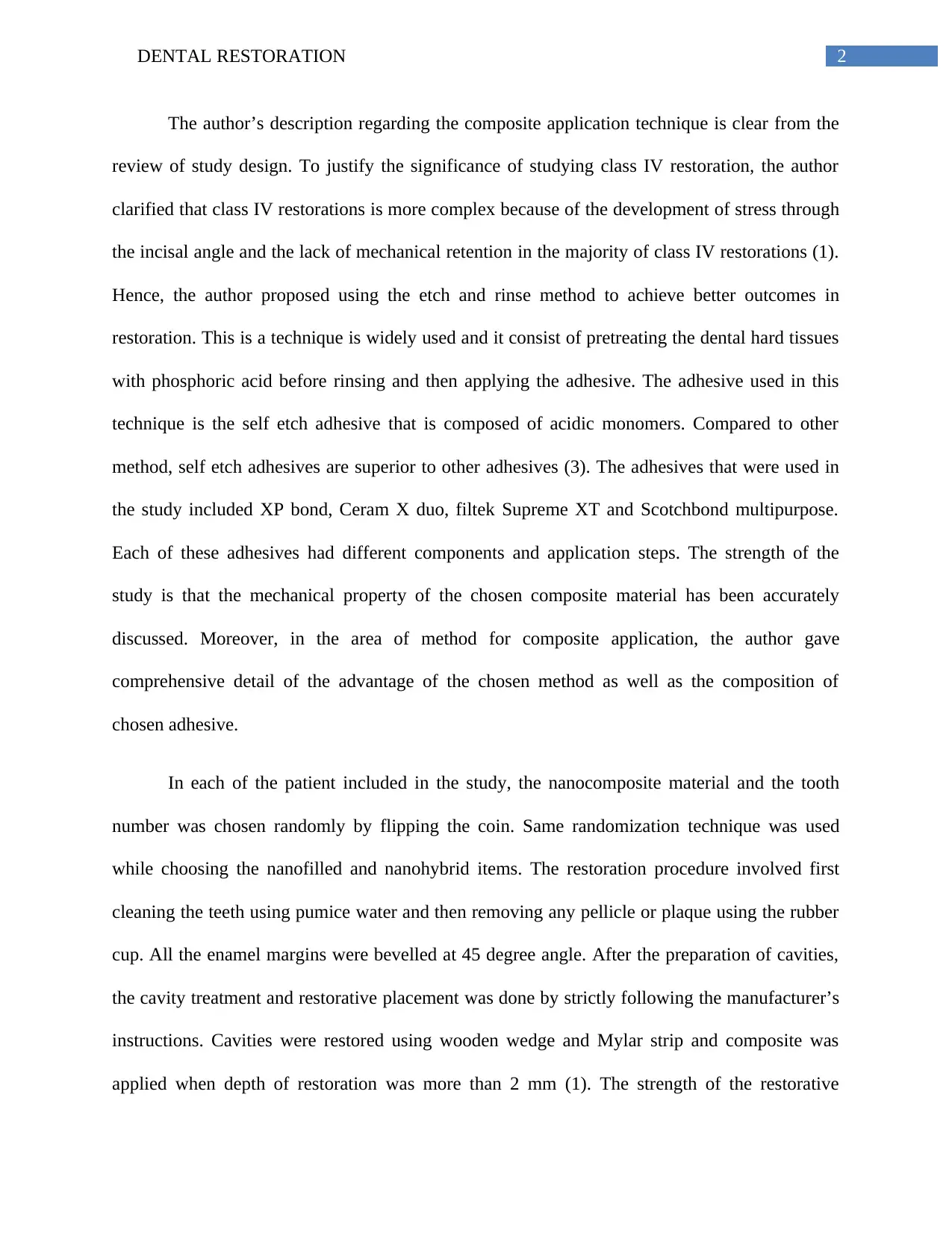
2DENTAL RESTORATION
The author’s description regarding the composite application technique is clear from the
review of study design. To justify the significance of studying class IV restoration, the author
clarified that class IV restorations is more complex because of the development of stress through
the incisal angle and the lack of mechanical retention in the majority of class IV restorations (1).
Hence, the author proposed using the etch and rinse method to achieve better outcomes in
restoration. This is a technique is widely used and it consist of pretreating the dental hard tissues
with phosphoric acid before rinsing and then applying the adhesive. The adhesive used in this
technique is the self etch adhesive that is composed of acidic monomers. Compared to other
method, self etch adhesives are superior to other adhesives (3). The adhesives that were used in
the study included XP bond, Ceram X duo, filtek Supreme XT and Scotchbond multipurpose.
Each of these adhesives had different components and application steps. The strength of the
study is that the mechanical property of the chosen composite material has been accurately
discussed. Moreover, in the area of method for composite application, the author gave
comprehensive detail of the advantage of the chosen method as well as the composition of
chosen adhesive.
In each of the patient included in the study, the nanocomposite material and the tooth
number was chosen randomly by flipping the coin. Same randomization technique was used
while choosing the nanofilled and nanohybrid items. The restoration procedure involved first
cleaning the teeth using pumice water and then removing any pellicle or plaque using the rubber
cup. All the enamel margins were bevelled at 45 degree angle. After the preparation of cavities,
the cavity treatment and restorative placement was done by strictly following the manufacturer’s
instructions. Cavities were restored using wooden wedge and Mylar strip and composite was
applied when depth of restoration was more than 2 mm (1). The strength of the restorative
The author’s description regarding the composite application technique is clear from the
review of study design. To justify the significance of studying class IV restoration, the author
clarified that class IV restorations is more complex because of the development of stress through
the incisal angle and the lack of mechanical retention in the majority of class IV restorations (1).
Hence, the author proposed using the etch and rinse method to achieve better outcomes in
restoration. This is a technique is widely used and it consist of pretreating the dental hard tissues
with phosphoric acid before rinsing and then applying the adhesive. The adhesive used in this
technique is the self etch adhesive that is composed of acidic monomers. Compared to other
method, self etch adhesives are superior to other adhesives (3). The adhesives that were used in
the study included XP bond, Ceram X duo, filtek Supreme XT and Scotchbond multipurpose.
Each of these adhesives had different components and application steps. The strength of the
study is that the mechanical property of the chosen composite material has been accurately
discussed. Moreover, in the area of method for composite application, the author gave
comprehensive detail of the advantage of the chosen method as well as the composition of
chosen adhesive.
In each of the patient included in the study, the nanocomposite material and the tooth
number was chosen randomly by flipping the coin. Same randomization technique was used
while choosing the nanofilled and nanohybrid items. The restoration procedure involved first
cleaning the teeth using pumice water and then removing any pellicle or plaque using the rubber
cup. All the enamel margins were bevelled at 45 degree angle. After the preparation of cavities,
the cavity treatment and restorative placement was done by strictly following the manufacturer’s
instructions. Cavities were restored using wooden wedge and Mylar strip and composite was
applied when depth of restoration was more than 2 mm (1). The strength of the restorative
⊘ This is a preview!⊘
Do you want full access?
Subscribe today to unlock all pages.

Trusted by 1+ million students worldwide
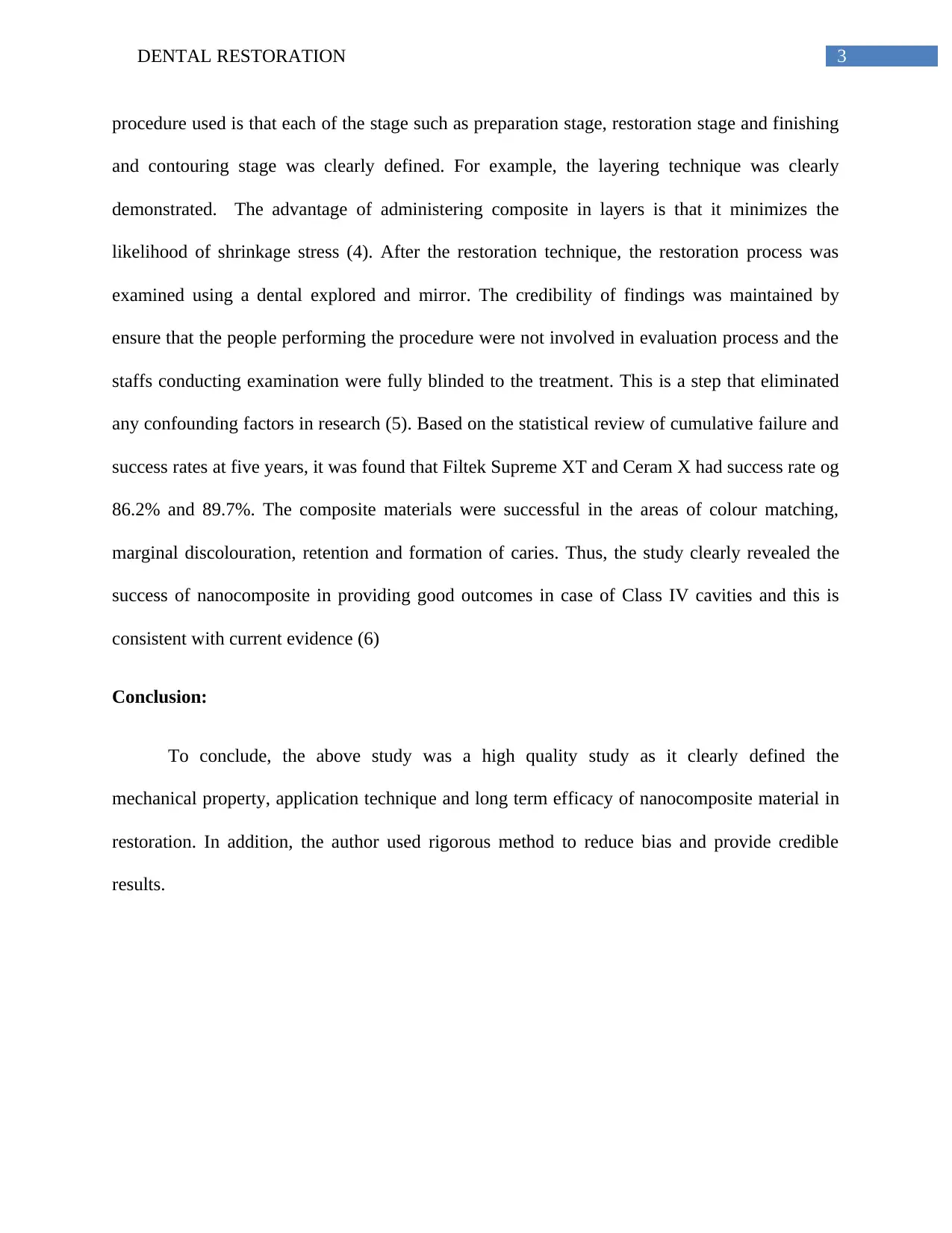
3DENTAL RESTORATION
procedure used is that each of the stage such as preparation stage, restoration stage and finishing
and contouring stage was clearly defined. For example, the layering technique was clearly
demonstrated. The advantage of administering composite in layers is that it minimizes the
likelihood of shrinkage stress (4). After the restoration technique, the restoration process was
examined using a dental explored and mirror. The credibility of findings was maintained by
ensure that the people performing the procedure were not involved in evaluation process and the
staffs conducting examination were fully blinded to the treatment. This is a step that eliminated
any confounding factors in research (5). Based on the statistical review of cumulative failure and
success rates at five years, it was found that Filtek Supreme XT and Ceram X had success rate og
86.2% and 89.7%. The composite materials were successful in the areas of colour matching,
marginal discolouration, retention and formation of caries. Thus, the study clearly revealed the
success of nanocomposite in providing good outcomes in case of Class IV cavities and this is
consistent with current evidence (6)
Conclusion:
To conclude, the above study was a high quality study as it clearly defined the
mechanical property, application technique and long term efficacy of nanocomposite material in
restoration. In addition, the author used rigorous method to reduce bias and provide credible
results.
procedure used is that each of the stage such as preparation stage, restoration stage and finishing
and contouring stage was clearly defined. For example, the layering technique was clearly
demonstrated. The advantage of administering composite in layers is that it minimizes the
likelihood of shrinkage stress (4). After the restoration technique, the restoration process was
examined using a dental explored and mirror. The credibility of findings was maintained by
ensure that the people performing the procedure were not involved in evaluation process and the
staffs conducting examination were fully blinded to the treatment. This is a step that eliminated
any confounding factors in research (5). Based on the statistical review of cumulative failure and
success rates at five years, it was found that Filtek Supreme XT and Ceram X had success rate og
86.2% and 89.7%. The composite materials were successful in the areas of colour matching,
marginal discolouration, retention and formation of caries. Thus, the study clearly revealed the
success of nanocomposite in providing good outcomes in case of Class IV cavities and this is
consistent with current evidence (6)
Conclusion:
To conclude, the above study was a high quality study as it clearly defined the
mechanical property, application technique and long term efficacy of nanocomposite material in
restoration. In addition, the author used rigorous method to reduce bias and provide credible
results.
Paraphrase This Document
Need a fresh take? Get an instant paraphrase of this document with our AI Paraphraser
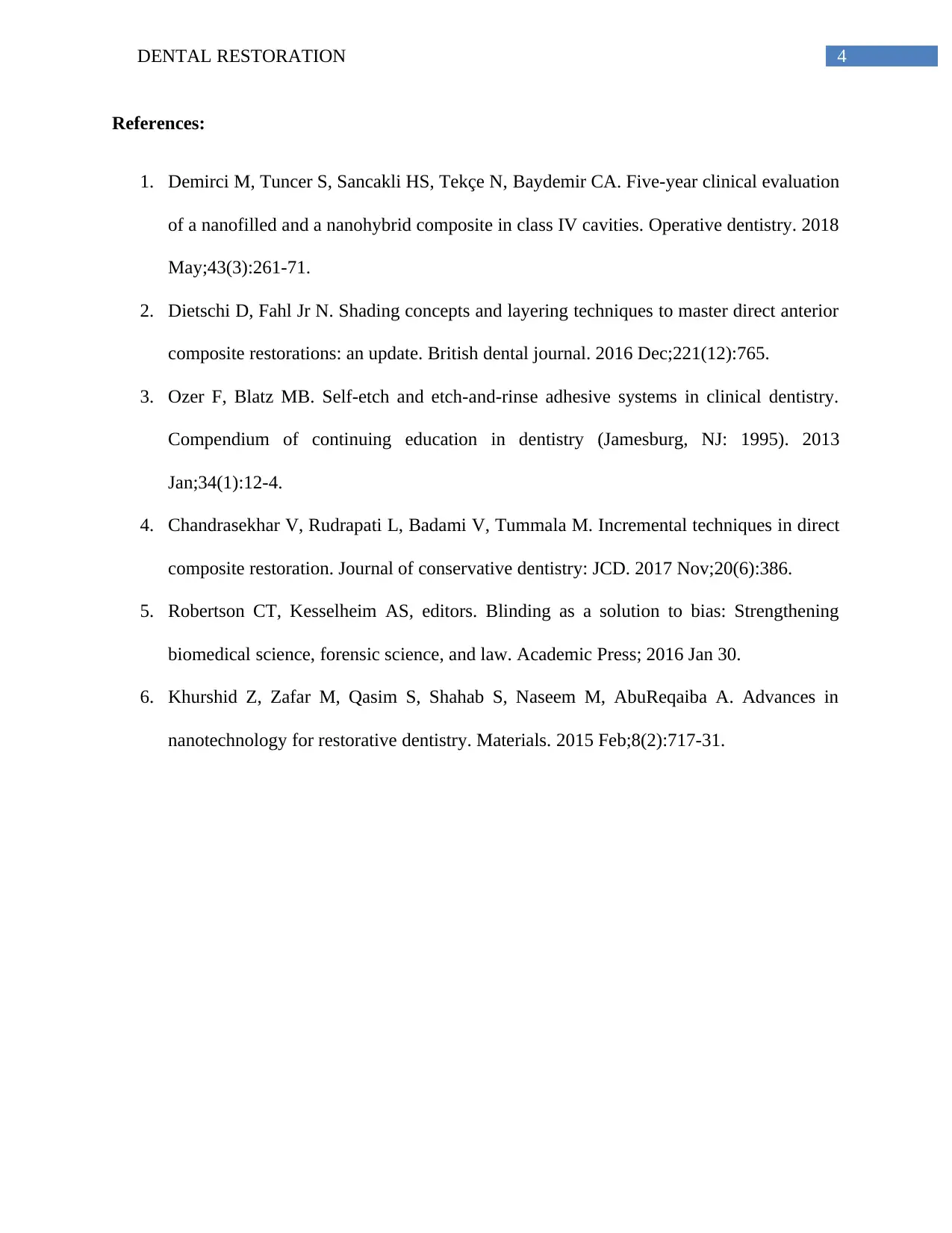
4DENTAL RESTORATION
References:
1. Demirci M, Tuncer S, Sancakli HS, Tekçe N, Baydemir CA. Five-year clinical evaluation
of a nanofilled and a nanohybrid composite in class IV cavities. Operative dentistry. 2018
May;43(3):261-71.
2. Dietschi D, Fahl Jr N. Shading concepts and layering techniques to master direct anterior
composite restorations: an update. British dental journal. 2016 Dec;221(12):765.
3. Ozer F, Blatz MB. Self-etch and etch-and-rinse adhesive systems in clinical dentistry.
Compendium of continuing education in dentistry (Jamesburg, NJ: 1995). 2013
Jan;34(1):12-4.
4. Chandrasekhar V, Rudrapati L, Badami V, Tummala M. Incremental techniques in direct
composite restoration. Journal of conservative dentistry: JCD. 2017 Nov;20(6):386.
5. Robertson CT, Kesselheim AS, editors. Blinding as a solution to bias: Strengthening
biomedical science, forensic science, and law. Academic Press; 2016 Jan 30.
6. Khurshid Z, Zafar M, Qasim S, Shahab S, Naseem M, AbuReqaiba A. Advances in
nanotechnology for restorative dentistry. Materials. 2015 Feb;8(2):717-31.
References:
1. Demirci M, Tuncer S, Sancakli HS, Tekçe N, Baydemir CA. Five-year clinical evaluation
of a nanofilled and a nanohybrid composite in class IV cavities. Operative dentistry. 2018
May;43(3):261-71.
2. Dietschi D, Fahl Jr N. Shading concepts and layering techniques to master direct anterior
composite restorations: an update. British dental journal. 2016 Dec;221(12):765.
3. Ozer F, Blatz MB. Self-etch and etch-and-rinse adhesive systems in clinical dentistry.
Compendium of continuing education in dentistry (Jamesburg, NJ: 1995). 2013
Jan;34(1):12-4.
4. Chandrasekhar V, Rudrapati L, Badami V, Tummala M. Incremental techniques in direct
composite restoration. Journal of conservative dentistry: JCD. 2017 Nov;20(6):386.
5. Robertson CT, Kesselheim AS, editors. Blinding as a solution to bias: Strengthening
biomedical science, forensic science, and law. Academic Press; 2016 Jan 30.
6. Khurshid Z, Zafar M, Qasim S, Shahab S, Naseem M, AbuReqaiba A. Advances in
nanotechnology for restorative dentistry. Materials. 2015 Feb;8(2):717-31.
1 out of 5
Your All-in-One AI-Powered Toolkit for Academic Success.
+13062052269
info@desklib.com
Available 24*7 on WhatsApp / Email
![[object Object]](/_next/static/media/star-bottom.7253800d.svg)
Unlock your academic potential
Copyright © 2020–2025 A2Z Services. All Rights Reserved. Developed and managed by ZUCOL.